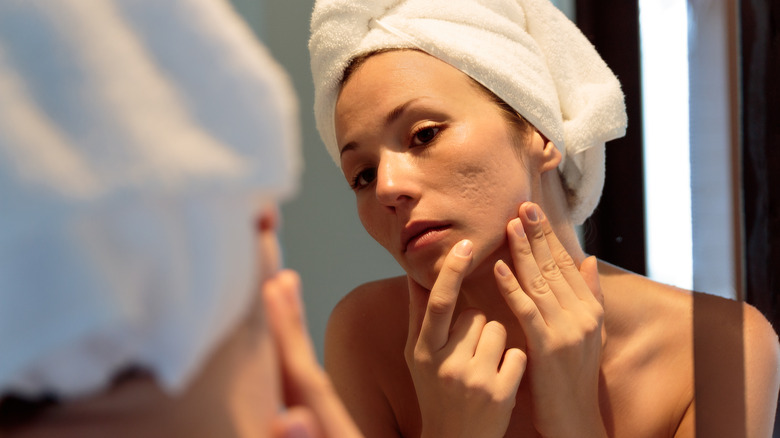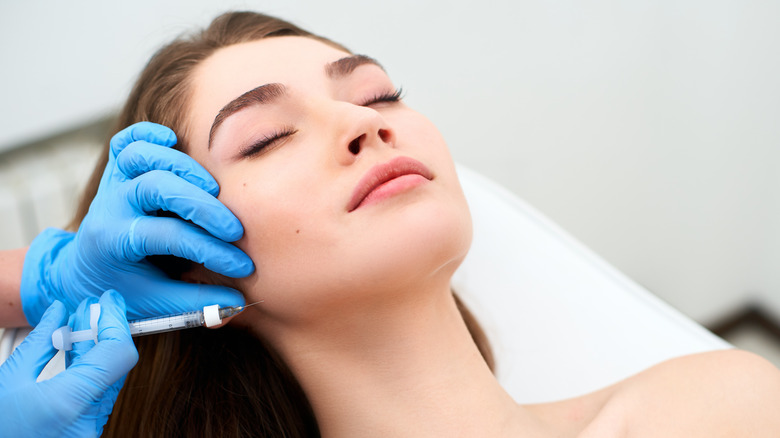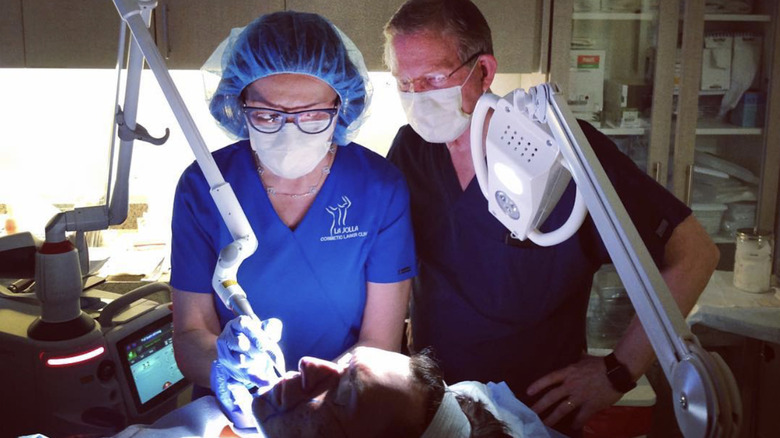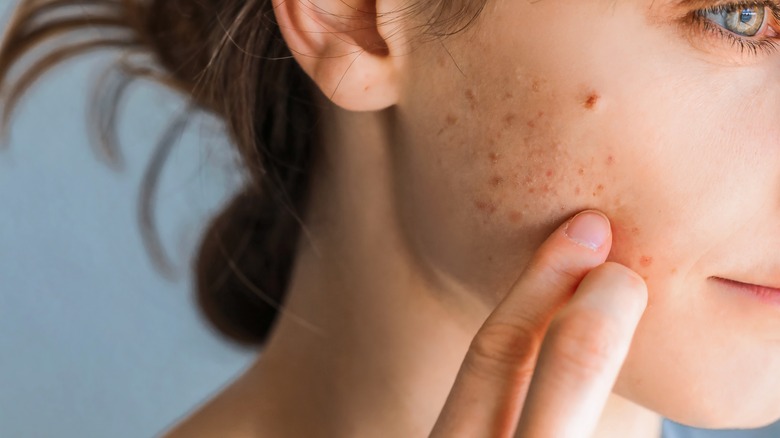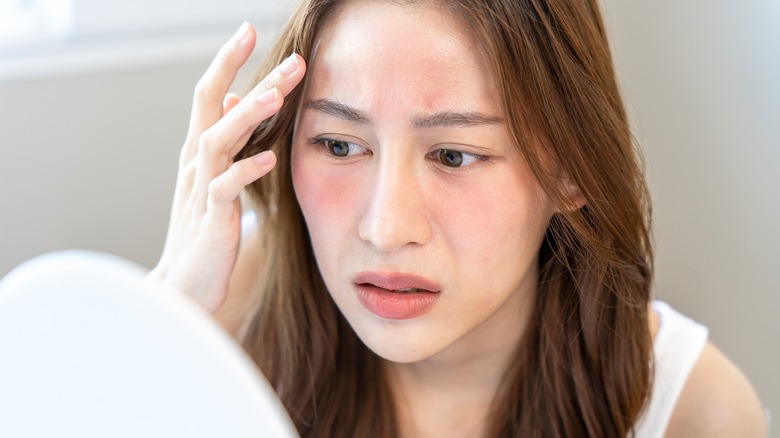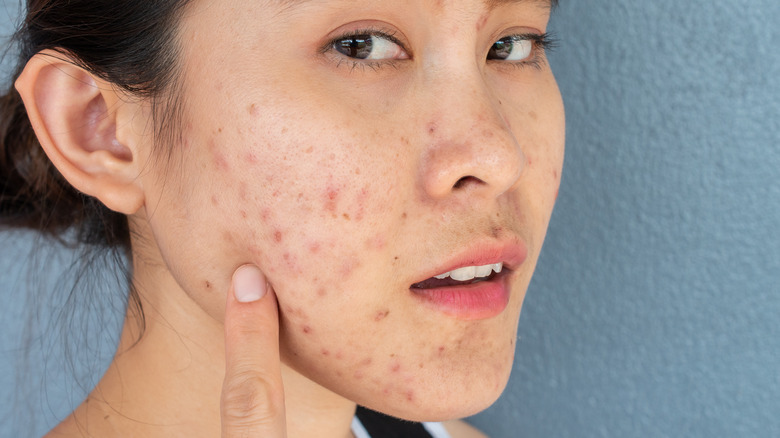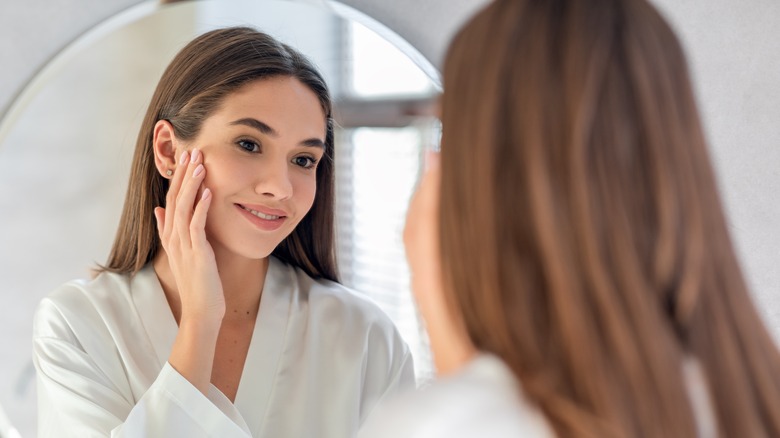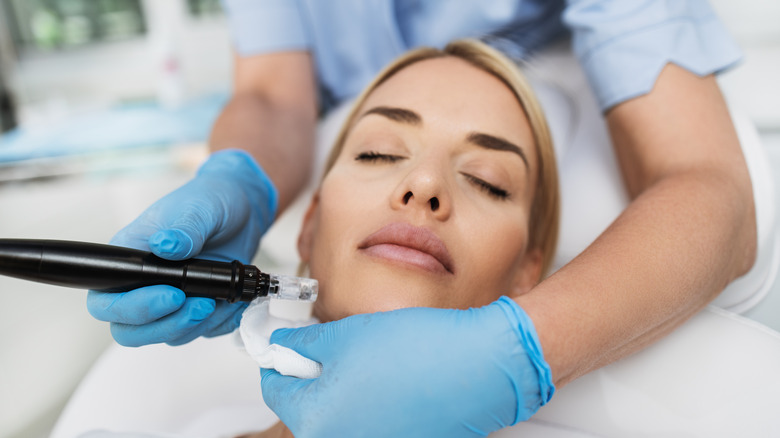Your Guide To The Subcision Procedure For Acne Scars
Being faced with a bright red, irritated pimple is annoying to begin with, but what comes after can be an even more frustrating process. As acne heals, you'll often be left with discoloration and dark marks, but deeper, cystic acne might result in full-blown scarring. These scars can present as raised bumps or slightly depressed areas depending on how they healed, but, either way, they're notoriously difficult to treat.
At-home treatments to reduce the appearance of acne scarring exist, but if you're looking for more effective results, you'll likely have to schedule an appointment with a dermatologist or esthetician. Laser treatments, small amounts of filler, and chemical peels are all popular choices depending on your budget and the severity of your scarring, but there's another treatment that promises noticeable results in an outpatient procedure, often for a lower price than laser removal. This treatment is called subcision, also known as subcutaneous incisionless surgery, and is a relatively simple process that allows your skin to heal itself after acne scars develop.
It involves inserting a small needle under the skin
According to the Journal of Subcutaneous and Aesthetic Surgery, the process of subcision involves the insertion of a needle — sorry to anyone with a phobia — under the top layer of the skin. This needle is usually 18 or 20 gauge, so about the same size as what you'd see if you were to get your ears pierced. It's inserted parallel to the skin, then rocked back and forth to break up bands of fibrous tissue that connect to the skin's surface, breaking up connections that cause visible acne scarring.
After the needle is removed, a bit of pressure is applied to avoid excess blood pooling. Under the skin, a small blood clot is allowed to form as the skin heals, essentially propping up the previously depressed skin and supporting it as it heals back into place. You might still see scarring and texture on the surface after this procedure, but the depth of the marks should be significantly reduced.
It's performed under local anesthesia
Moving a needle around under the surface of the skin doesn't exactly sound like a pleasant experience, but, luckily, this procedure is performed under local anesthesia, meaning you'll still be awake, but the area will be completely numbed. Instead of pain, you'll likely feel more of a dull pressure, but always mention if you're experiencing higher levels of pain than you'd expect after being numbed — some people have different tolerances for anesthesia, so it's notoriously difficult to dose.
While you're getting the procedure done, you also might hear a quiet popping noise. This is the result of the needle breaking up those subcutaneous fibrous bands under the skin. The noise might be a bit uncomfortable, but it's to be expected with this procedure — just take it as evidence that the treatment is working. Because this procedure is minimally invasive, you might still be a bit numb, but you can go about the rest of your day after you leave the doctor's office.
You should notify your doctor if you're on blood thinners
Because this procedure involves intentionally causing a bit of damage to the skin, it's important to let your doctor know if you're on any medications that thin your blood. More obvious medications designed to thin the blood include Xarelto and Effient, but something as common as Tylenol should also be mentioned or avoided before your procedure (via Drugwatch). A few supplements also have blood-thinning side effects, like Vitamin E and ginkgo, so make sure to do some research on what you're taking before heading into the office.
If you're on acne medication, this is also important to mention, especially if you're using Accutane. It's easy to see cosmetic procedures as something separate from a normal trip to the doctor's office, but, by speaking to your dermatologist and being open with your doctor, you'll ensure that you see the best results from your procedure and avoid any side effects.
There is a small risk of infection
As with all procedures that involve damaging the skin, there is a small risk of infection. Because of this, it's important to ensure that you're going to a qualified professional for your subcision treatment. The area should be sterilized, the room should be clean and sanitary, and your doctor should always be using a brand new needle. If anything seems off, seek another doctor — it's not worth the risk.
After you leave your appointment, it's still important to keep your face clean while it heals. Avoid applying any harsh skincare ingredients on the area and instead focus on gentle cleansing, moisturization, and sun protection. It's also best to avoid anything that will leave you sweaty, like heavy workouts, saunas, and trips to the beach, along with exposure to water that could be dirty, like public pools or lakes. After the surface of your skin heals, you can resume your typical skincare routine and activities.
You could face swelling and irritation after the procedure
A few days after your subcision treatment, you could face some swelling and redness as your skin heals. This is normal — you did just have a needle in your face — and should calm down in a couple of days. Right after your procedure, your doctor will likely give you a cold compress to apply to your skin to reduce any discomfort, and you can continue with a similar approach after you get home. Apply an ice pack wrapped in a towel when you're feeling particularly swollen, or try placing your skincare products in the fridge for a boost of soothing coolness in the morning.
If your healing process seems to be continuing for longer than expected, or if you find yourself in severe discomfort, call your doctor or head to the emergency room. Look out for signs of infection like itching, rashes, pus, or fever. While this is rare, it could develop into a major issue if left untreated.
It might take multiple treatments to see desired results
As with any cosmetic procedure, everyone sees different results based on the severity of what they're working to treat and their skin's receptiveness. This procedure won't completely eliminate scars — they still might be a slightly different color or texture from the rest of your skin — but it helps reduce their depth and allows them to flow more seamlessly with the rest of the face. You might have to go in multiple times if you have some scars that are deeper than others.
It's also important to note that this procedure doesn't prevent future scarring. If you're still facing active, deep breakouts, you might still continue to see acne scars pop up across your face. Going back in once these breakouts fade can still help reduce their appearance, but working to prevent acne from popping up in the first place and avoiding the urge to pop or pick active breakouts can help eliminate the issue before it starts.
Your skin will produce collagen while healing
Collagen is an essential component of healthy, youthful skin, but as we age, our supply naturally begins to decrease, resulting in less plump and glowy skin. When your skin is healing, however, collagen production kicks back up to repair the damaged area, so procedures that involve a bit of irritation or damage can actually leave you looking a bit more youthful. This is commonly seen in microneedling, but subcision can have the same impacts, just in more concentrated areas.
With that being said, however, don't expect a brand new face. Subcision targets specific areas where you're seeing the most severe scarring, so if you want a full-face plumping treatment, it's a better idea to go for a chemical peel, microneedling, or even a bit of filler. This procedure was designed to combat acne scarring as its primary focus, but you just might see an unexpected benefit after a few days of healing.
You can use subcision in conjunction with other treatments
Subcision helps to treat acne scarring from under the skin, but it's often paired with other procedures to tackle the issue from the outside as well. Laser treatments and chemical peels are also commonly included as part of the treatment plan to create an overall smooth, blemish-free look. Consult with your doctor to determine an exact treatment plan that includes ways to fight existing acne, prevent new breakouts, minimize scarring, and improve skin texture.
This procedure can be intimidating when you first learn how it works, but, compared to more involved cosmetic surgeries, it's fairly simple and non-invasive. There's no reason to be afraid of going under the needle — just ensure you find a doctor you trust and you take proper care of your skin after you leave the office. After a few days of healing, you'll be right back to normal, just with a smoother complexion.
